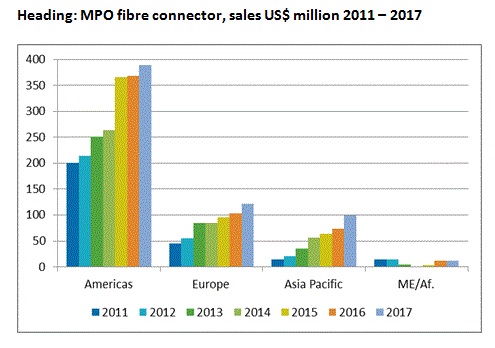Global cabling market 2017
The recently published BSRIA market intelligence study shows a global increase of pre-terminated fibre connectivity of more than 11% in 2017.
The structured cabling market increased by almost 2% in 2017 to USD 6.4 billion, compared to a 1% increase in 2016. The cabling installed in data centres performed significantly better than the Local Area Network (LAN) market, increasing by almost 5% compared to 1.2% for the LAN segment.
Lone Hansen, Senior Manager – IT Cabling, BACS & Associated Technologies, WMI, said:
“Sales of fibre connectivity increased by four per cent and single mode fibre cables by 10% in 2017, while sales of copper cable and connectivity increased only marginally. Sales of pre-terminated fibre units (cassettes, connectors and trunk cables), which is a subset of fibre connectivity, increased by over 11% in 2017, to USD 608 million.
The commoditisation of cabling with increasing sales of solutions sold by low cost suppliers and distributor's private labels continued in 2017 and are now including the whole product range, even Cat 6A cabling and pre-term fibre connectivity.
The average price of copper cable decreased by 1.7%. Some countries experienced price increases due to the increased cost of copper material and increasing sales of Cat 6A, but over-capacity in the industry, commoditisation and competition forced prices down in most countries. The share of high value plenum cables, mainly sold in the US, remained stable, accounting for close to 80% of sales in the US.”
Sales of Cat 6A have increased and account for 29% of all cabling systems by value in 2017 up from 27% in 2016. Sales of Cat 6 dominates the global market with over half the sales.
This year's study (published June 2018) included 33 countries and South East Asia. 14 countries were researched in 2017/18, and 10 countries in 2016 (Columbia, Denmark, Egypt, Finland, Italy, Qatar, Russia, South Korea, Switzerland and Turkey). Data from a further seven countries researched in 2015 is included (Argentina, Austria, Australia, Belgium, Canada, Saudi Arabia and Sweden) and the Netherlands, Peru and Poland from 2014.
Countries not included account for an additional 5-10% bringing the total global structured cabling market to an estimated USD 6.9 billion.
This article was originally published here by BSRIA in September 2018.
--BSRIA
[edit] Related articles on Designing Buildings Wiki
Featured articles and news
RTPI leader to become new CIOB Chief Executive Officer
Dr Victoria Hills MRTPI, FICE to take over after Caroline Gumble’s departure.
Social and affordable housing, a long term plan for delivery
The “Delivering a Decade of Renewal for Social and Affordable Housing” strategy sets out future path.
A change to adoptive architecture
Effects of global weather warming on architectural detailing, material choice and human interaction.
The proposed publicly owned and backed subsidiary of Homes England, to facilitate new homes.
How big is the problem and what can we do to mitigate the effects?
Overheating guidance and tools for building designers
A number of cool guides to help with the heat.
The UK's Modern Industrial Strategy: A 10 year plan
Previous consultation criticism, current key elements and general support with some persisting reservations.
Building Safety Regulator reforms
New roles, new staff and a new fast track service pave the way for a single construction regulator.
Architectural Technologist CPDs and Communications
CIAT CPD… and how you can do it!
Cooling centres and cool spaces
Managing extreme heat in cities by directing the public to places for heat stress relief and water sources.
Winter gardens: A brief history and warm variations
Extending the season with glass in different forms and terms.
Restoring Great Yarmouth's Winter Gardens
Transforming one of the least sustainable constructions imaginable.
Construction Skills Mission Board launch sector drive
Newly formed government and industry collaboration set strategy for recruiting an additional 100,000 construction workers a year.
New Architects Code comes into effect in September 2025
ARB Architects Code of Conduct and Practice available with ongoing consultation regarding guidance.
Welsh Skills Body (Medr) launches ambitious plan
The new skills body brings together funding and regulation of tertiary education and research for the devolved nation.
Paul Gandy FCIOB announced as next CIOB President
Former Tilbury Douglas CEO takes helm.
UK Infrastructure: A 10 Year Strategy. In brief with reactions
With the National Infrastructure and Service Transformation Authority (NISTA).

























